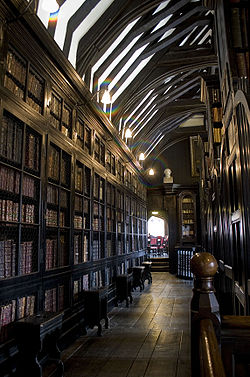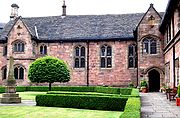
Chetham's Library
Encyclopedia

Manchester
Manchester is a city and metropolitan borough in Greater Manchester, England. According to the Office for National Statistics, the 2010 mid-year population estimate for Manchester was 498,800. Manchester lies within one of the UK's largest metropolitan areas, the metropolitan county of Greater...
, England is the oldest free public reference library in the United Kingdom. Chetham's Hospital, which contains both the library and Chetham's School of Music
Chetham's School of Music
Chetham's School of Music , familiarly known as "Chets", is a specialist independent co-educational music school, situated in Manchester city centre, in North West England. It was established in 1969, incorporating Chetham's Hospital School, founded as a charity school by Humphrey Chetham in 1653...
, was established in 1653 under the will of Humphrey Chetham
Humphrey Chetham
Sir Humphrey Chetham was an English merchant, responsible for the creation of Chetham's Hospital and Chetham's Library, the oldest public library in the English-speaking world.- Life :...
(1580–1653), for the education of "the sons of honest, industrious and painful parents", and a library for the use of scholars. The library has been in continuous use since 1653. It operates as an independent charity, open to readers and visitors free of charge.
The library holds more than 100,000 volumes of printed books, of which 60,000 were published before 1851. They include collections of 16th- and 17th-century printed works, periodicals and journals, local history sources, broadside
Broadside (printing)
A broadside is a large sheet of paper printed on one side only. Historically, broadsides were posters, announcing events or proclamations, or simply advertisements...
s and ephemera
Ephemera
Ephemera are transitory written and printed matter not intended to be retained or preserved. The word derives from the Greek, meaning things lasting no more than a day. Some collectible ephemera are advertising trade cards, airsickness bags, bookmarks, catalogues, greeting cards, letters,...
.
Chetham's was the meeting place of Karl Marx
Karl Marx
Karl Heinrich Marx was a German philosopher, economist, sociologist, historian, journalist, and revolutionary socialist. His ideas played a significant role in the development of social science and the socialist political movement...
and Friedrich Engels
Friedrich Engels
Friedrich Engels was a German industrialist, social scientist, author, political theorist, philosopher, and father of Marxist theory, alongside Karl Marx. In 1845 he published The Condition of the Working Class in England, based on personal observations and research...
when Marx visited Manchester. The economics books Marx was reading at the time can be seen on a shelf in the library, as can the window seat where Marx and Engels would meet.
History

Lord of the Manor
The Lordship of a Manor is recognised today in England and Wales as a form of property and one of three elements of a manor that may exist separately or be combined and may be held in moieties...
, in the centre of the medieval town of Manchester, stood on a sandstone
Sandstone
Sandstone is a sedimentary rock composed mainly of sand-sized minerals or rock grains.Most sandstone is composed of quartz and/or feldspar because these are the most common minerals in the Earth's crust. Like sand, sandstone may be any colour, but the most common colours are tan, brown, yellow,...
bluff
Cliff
In geography and geology, a cliff is a significant vertical, or near vertical, rock exposure. Cliffs are formed as erosion landforms due to the processes of erosion and weathering that produce them. Cliffs are common on coasts, in mountainous areas, escarpments and along rivers. Cliffs are usually...
, at the confluence of the River Irwell
River Irwell
The River Irwell is a long river which flows through the Irwell Valley in the counties of Lancashire and Greater Manchester in North West England. The river's source is at Irwell Springs on Deerplay Moor, approximately north of Bacup, in the parish of Cliviger, Lancashire...
and the River Irk
River Irk
The River Irk is a river in Greater Manchester in North West England that flows through the northern suburbs of Manchester before merging with the River Irwell in Manchester city centre....
. In 1421 the rector of the parish church, Thomas de la Warre
Thomas la Warr, 5th Baron De La Warr
Thomas la Warr, 5th Baron De La Warr was the second son of Roger la Warr, 3rd Baron De La Warr and Elizabeth de Welle, daughter of Adam, 3rd Baron Welles, and was intended for the church. In 1363, he received a dispensation, permitting him to be ordained at the age of twenty, and was made a canon...
(Lord of the manor of Manchester), obtained a licence from Henry V
Henry V of England
Henry V was King of England from 1413 until his death at the age of 35 in 1422. He was the second monarch belonging to the House of Lancaster....
to refound the church as a collegiate foundation. He donated his manor house for use as the college of priests' buildings for the collegiate church
Collegiate church
In Christianity, a collegiate church is a church where the daily office of worship is maintained by a college of canons; a non-monastic, or "secular" community of clergy, organised as a self-governing corporate body, which may be presided over by a dean or provost...
(later to be the cathedral
Manchester Cathedral
Manchester Cathedral is a medieval church on Victoria Street in central Manchester and is the seat of the Bishop of Manchester. The cathedral's official name is The Cathedral and Collegiate Church of St Mary, St Denys and St George in Manchester...
). There was accommodation for the warden, eight fellows, four clerks, and six choristers.
The Manchester Free Grammar School for Lancashire Boys
Manchester Grammar School
The Manchester Grammar School is the largest independent day school for boys in the UK . It is based in Manchester, England...
was built between the church and the college buildings between 1515 and 1518. The college was dissolved in 1547 by the Chantries Act and sold to the Earl of Derby
Earl of Derby
Earl of Derby is a title in the Peerage of England. The title was first adopted by Robert de Ferrers, 1st Earl of Derby under a creation of 1139. It continued with the Ferrers family until the 6th Earl forfeited his property toward the end of the reign of Henry III and died in 1279...
. It was re-founded as a catholic foundation by Queen Mary
Mary I of England
Mary I was queen regnant of England and Ireland from July 1553 until her death.She was the only surviving child born of the ill-fated marriage of Henry VIII and his first wife Catherine of Aragon. Her younger half-brother, Edward VI, succeeded Henry in 1547...
and again disbanded by Protestant Queen Elizabeth I
Elizabeth I of England
Elizabeth I was queen regnant of England and Ireland from 17 November 1558 until her death. Sometimes called The Virgin Queen, Gloriana, or Good Queen Bess, Elizabeth was the fifth and last monarch of the Tudor dynasty...
. In 1578 it was re-founded by charter as Christ's College and re-occupied by the warden and fellows. In the Civil War
English Civil War
The English Civil War was a series of armed conflicts and political machinations between Parliamentarians and Royalists...
it was used as a prison and arsenal.
In 1653 the college buildings were bought with the bequest of Humphrey Chetham, for use as a free library and blue coat charity school
Charity school
A charity school, also called Blue Coat School, was significant in the History of education in England. They were erected and maintained in various parishes, by the voluntary contributions of the inhabitants, for teaching poor children to read, write, and other necessary parts of education...
. At that time there was no facility for independent study in the north of England and Chetham's will of 1651 had stipulated that the Library should be 'for the use of schollars and others well affected', and instructed the librarian 'to require nothing of any man that cometh into the library'. The twenty four feoffees, or governors, appointed by Humphrey Chetham, set out to acquire a major collection of books and manuscripts that would cover the whole range of available knowledge and would rival the college libraries of Oxford and Cambridge. In order to protect the newly acquired books from rising damp the Library was housed on the first floor and, in accordance with the provisions of Chetham's will, the books were chained to the presses (bookcases). Twenty-four carved oak stools with 'S'-shaped hand-holds (which are still in use) were provided as seats for readers.
In 1718 the feoffees offered the Manchester poet and inventor of a system of shorthand
Shorthand
Shorthand is an abbreviated symbolic writing method that increases speed or brevity of writing as compared to a normal method of writing a language. The process of writing in shorthand is called stenography, from the Greek stenos and graphē or graphie...
, John Byrom
John Byrom
John Byrom or John Byrom of Kersal or John Byrom of Manchester FRS was an English poet and inventor of a revolutionary system of shorthand. He is also remembered as the writer of the lyrics of Anglican hymn Christians Awake, salute the happy morn.- Early life :John Byrom was descended from an old...
, the post of Library Keeper. Byrom, who was an avid collector of books, declined the offer but after his good friend, Robert Thyer, became Librarian in 1732, frequently acted as an agent for the library, purchasing books at London auctions. Byrom's library, which included the manuscript of his poem "Christmas Day" (which became the Christmas carol, "Christians Awake") and some 2,800 printed books, was presented to the library by his descendant, Eleanora Atherton, in 1870.
The books were originally uncatalogued and placed in the presses in size order. The first catalogue wasn't produced until 1791, and then was written in Latin and only listed the size and subject of each book. The practice of chaining the books was abandoned in the mid eighteenth century when gates were erected to prevent theft.
Additions were made to the buildings by J. E. Gregan (1850s), Alfred Waterhouse
Alfred Waterhouse
Alfred Waterhouse was a British architect, particularly associated with the Victorian Gothic Revival architecture. He is perhaps best known for his design for the Natural History Museum in London, and Manchester Town Hall, although he also built a wide variety of other buildings throughout the...
(1878) (grade II listed), and J. Medland Taylor (1883–95). Manchester Grammar School was extended along Long Millgate in 1870. Manchester Grammar School moved to Fallowfield
Fallowfield
Ladybarn is the part of Fallowfield to the south-east. Chancellors Hotel & Conference Centre is used by the University of Manchester: it was built by Edward Walters for Sir Joseph Whitworth, as were the Firs Botanical Grounds.-Religion:...
in the 1930s, and after standing empty for many years the original building was destroyed during the Second World War, leaving only its new block. This became part of Chetham's School of Music in 1978. The old college building, which became the music school in 1969, still incorporates Chetham's Library and is Grade I listed.
Librarians
Past librarians include Robert Thyer (1709–1781), who became Librarian in 1732. Peter Hordern (died 1836) was librarian and also the minister of St Clement's Chapel, Chorlton-cum-HardyChorlton-cum-Hardy
Chorlton-cum-Hardy is a suburban area of the city of Manchester, England. It is known locally as Chorlton. It is situated about four miles southwest of Manchester city centre. Pronunciation varies: and are both common....
. Thomas Jones
Thomas Jones (librarian)
Thomas Jones was a Welsh librarian, who was librarian of Chetham's Library in Manchester from 1845 to 1875.-Life:...
held the position from 1845 to 1875; during his time, the size of the library more than doubled (from 19,000 volumes to 40,000 volumes). He also produced a two-volume catalogue of the library's collection in 1862 and 1863.

